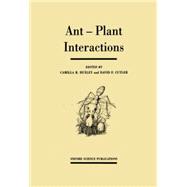
Note: Supplemental materials are not guaranteed with Rental or Used book purchases.
Purchase Benefits
What is included with this book?
| Ants and Plants: A Diversity of Interaction | |
| Antagonistic Interactions - The Leaf-Cutter Ants | |
| An Introduction to the Fungus-Growing Ants | |
| The Selection and Detoxification of Plant Material by Fungus-Growing Ants | |
| Resource Quality and Cost in the Foraging of Leaf-Cutter Ants | |
| Leaf-Cutter Ant Assemblies: Effects of Latitude, Vegetation, and Behaviour | |
| Ant-Plant Interactions Involving Herbivorous Insects | |
| Effects of Ants on Temperate Woodland Trees | |
| The Interaction Between Red Wood Ants, Cinara Aphids, and Pines: A Ghost of Mutualism Past? | |
| Conditional Interactions in Ant-Plant-Herbivore Mutualisms | |
| Why Are So Few Aphids Ant-Tended? | |
| Effects of Ant-Homopteran Systems on Fig-Figwasp Interactions | |
| Variation in the Attractiveness of Lycaenid Butterfly Larvae to Ants | |
| Evolutionary and Ecological Patterns in Myremecophilous Riodinids | |
| Extrafloral Nectary-Mediated Interactions | |
| Phylogeny, Lifeform, and Habitat Dependence of Ant-Defended Plants in a Panamanian Forest | |
| The Ant Community Associated with Extrafloral Nectaries in the Brazilian Cerrados | |
| Extrafloral Nectaries of Herbs and Trees: Modelling the Interaction with Ants and Parasitoids | |
| Bracken and Ants: Why is There No Mutualism? | |
| Some Associations Between Ants and Euphorbs in Tropical Australasia | |
| Symbiosis Between Plants and Ants | |
| The Association Between Macaranga Trees and Ants in South-east Asia, Brigitte Fiala | |
| Azteca Ants in Cecropia Trees: Taxonomy, Colony Structure, and Behavior | |
| Symbiosis of Ants with Cecropia As a Function of Light Regime | |
| Phylogenetic Analysis of the Evolution of a Mutualism: Leonardoxa (Caesalpiniaceae) and Its Associated Ants | |
| Phylogenetic Analysis of Psuedomyrmecine Ants associated with Domatia-Bearing Plants | |
| Myrmecotropy: Origins, Operation and Importance | |
| Cavity Structure and Function in the Tuberous Epiphytic Rubiaceae | |
| Parasitism of Ant-Plant Mutualisms and the Novel Case of Piper | |
| Ants, Plants, and Beetles: A Triangular Relationship | |
| Pollination, Ant-Exclusion and Dispersal | |
| The Evidence for, and Importance of, Ant Pollination | |
| The Greasy Pole Syndrome | |
| Seed Dispersal by Ants: Comparing Infertile with Fertile Soils | |
| Myrmecocheory in Cape Fynbos | |
| Light Environments, Stage-Structure, and Dispersal Syndromes of Costa Rican Marantaceae | |
| Ground Beetles and Seed Dispersal of the Myrmecochorous Plant Trillium tschonoskii (Liliaceae) | |
| Seed Harvesting by Ants in Australia | |
| Ants, Vegetation Ecology, and the Future of Ant-Plant Research | |
| The Influence of Mound Building Ants on British Lowland Vegetation | |
| A Neotropical, Rainforest Canopy, Ant Community: Some Ecological Considerations | |
| Table of Contents provided by Publisher. All Rights Reserved. |
The New copy of this book will include any supplemental materials advertised. Please check the title of the book to determine if it should include any access cards, study guides, lab manuals, CDs, etc.
The Used, Rental and eBook copies of this book are not guaranteed to include any supplemental materials. Typically, only the book itself is included. This is true even if the title states it includes any access cards, study guides, lab manuals, CDs, etc.